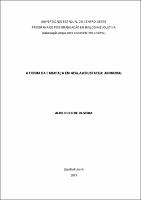| Compartilhamento |


|
Use este identificador para citar ou linkar para este item:
http://tede.unicentro.br:8080/jspui/handle/tede/411Registro completo de metadados
| Campo DC | Valor | Idioma |
|---|---|---|
| dc.creator | Oliveira, Aline Rossi de | - |
| dc.creator.Lattes | http://lattes.cnpq.br/6126481766173938 | por |
| dc.contributor.advisor1 | Metri, Rafael | - |
| dc.contributor.advisor1Lattes | http://lattes.cnpq.br/6403295150804669 | por |
| dc.date.accessioned | 2016-09-20T12:29:27Z | - |
| dc.date.available | 2015-12-07 | - |
| dc.date.issued | 2013-02-25 | - |
| dc.identifier.citation | OLIVEIRA, Aline Rossi de. não consta. 2013. 41 f. Dissertação (Mestrado em Biologia Evolutiva) - UNICENTRO - Universidade Estadual do Centro Oeste, Guarapuava, 2013. | por |
| dc.identifier.uri | http://localhost:8080/tede/handle/tede/411 | - |
| dc.description.resumo | Os caranguejos utilizados neste estudo pertencem à família Aeglidae, ocorrem em águas continentais e são endêmicos do sul da América do Sul. Possuem corpo oval e achatado dorsoventralmente e carapaça marcada por um complexo arranjo de suturas. Aeglidae possui apenas um único gênero atual, Aegla Leach, 1820 consistindo de aproximadamente 70 espécies descritas, divididas pela filogenia mais completa em 5 subclados: A-B, constituídos por espécies do sul da Argentina e Chile; C, ao longo da Bacia do Paraná; D, ao longo dos afluentes oeste e Bacia do Uruguai e E, ao longo da Bacia do Uruguai. No presente estudo aplicou-se técnicas de morfometria geométrica em eglídeos brasileiros para melhor compreensão das variações morfológicas inter e intra-específicas, investigando se os possíveis padrões de variação da forma da carapaça tem associação com adaptações locais das populações estudadas ou se representam padrões evolutivos fixados dentro das diferentes linhagens. Utilizou-se três espécies com alto grau de parentesco do subclado C, Aegla castro, A. parana, e A. schmitti e ainda uma espécie coletada para estudos anteriores no rio Bananas em Guarapuava-PR, e três espécies também aparentadas, mas em outro subclado (subclado E), A. ligulata, A. longirostri e A. inconspicua. Registrou-se diferença significativa na forma da carapaça entre as espécies e entre as populações de mesma e ainda espécies de clados distintos e no contexto deste estudo, pouco aparentadas, com forma da carapaça mais semelhantes entre si do que com espécies de seu clado. Podemos dizer, portanto, que estes caranguejos possuem uma parte fixa da forma da carapaça, que nos permitiu reconhecê-los usando a morfometria geométrica e outra parte plástica, fazendo com que populações sejam diferentes de acordo com as características do ambiente em que vivem. | por |
| dc.description.abstract | Crabs used in this study belong to the family Aeglidae occur in inland waters and are endemic to southern South America. They have oval body and flattened dorsoventrally and carapace marked by a complex arrangement of sutures. Aeglidae has only one current genus, Aegla Leach, 1820 consisting of approximately 70 described species, divided by more complete phylogeny in 5 subclados: A-B, consisting of species of southern Argentina and Chile; C, along the Paraná Basin; D over the affluent west and the Basin of Uruguay and E, along the Uruguay River Basin. In the present study we applied geometric morphometric techniques in Brazilian eglídeos for better understanding of morphological variation inter and intra-specific, is investigating the possible patterns of variation in the shape of the carapace is associated with local adaptations of populations or whether they represent evolutionary patterns set within the different lineages. We used three species with a high degree of relatedness of subclade C, Aegla castro, A. parana and A. schmitti and even a species collected for previous studies on the river Bananas in Guarapuava - PR, and three closely related species also, but in another subclade (subclade E), A. ligulata, A. longirostri and A. inconspicua. Reported a significant difference in the shape of the carapace among species and among populations of the same species and even distinct clades and in the context of this study, some allied with the carapace shape more similar to each other than with their species clade. We can say, therefore, that these crabs have a fixed shape of the carapace, which allowed us to recognize them using geometric morphometrics and part plastic, causing populations to differ according to the characteristics of the environment in which they live. | eng |
| dc.description.provenance | Made available in DSpace on 2016-09-20T12:29:27Z (GMT). No. of bitstreams: 1 PR ALINE ROSSI DE OLIVEIRA.pdf: 561750 bytes, checksum: fd90527f4791394e7d56f10f6e02b250 (MD5) Previous issue date: 2013-02-25 | eng |
| dc.description.sponsorship | Coordenação de Aperfeiçoamento de Pessoal de Nível Superior - CAPES | - |
| dc.format | application/pdf | por |
| dc.thumbnail.url | http://localhost:8080/tede/retrieve/1345/PR%20ALINE%20ROSSI%20DE%20OLIVEIRA.pdf.jpg | * |
| dc.language | por | por |
| dc.publisher | UNICENTRO - Universidade Estadual do Centro Oeste | por |
| dc.publisher.department | Unicentro::Departamento de Biologia | por |
| dc.publisher.country | BR | por |
| dc.publisher.initials | UNICENTRO | por |
| dc.publisher.program | Programa de Pós-Graduação em Biologia Evolutiva (Mestrado) | por |
| dc.rights | Acesso Aberto | por |
| dc.subject | Aeglidae | por |
| dc.subject | forma | por |
| dc.subject | evolução | por |
| dc.subject | Aeglidae | eng |
| dc.subject | shape | eng |
| dc.subject | evolution | eng |
| dc.subject.cnpq | CIENCIAS BIOLOGICAS::BIOLOGIA GERAL | por |
| dc.title | A FORMA DA CARAPAÇA EM AEGLA (CRUSTACEA: ANOMURA) | por |
| dc.title.alternative | não consta | eng |
| dc.type | Dissertação | por |
| Aparece nas coleções: | Programa de Pós-Graduação em Biologia Evolutiva | |
Arquivos associados a este item:
| Arquivo | Descrição | Tamanho | Formato | |
|---|---|---|---|---|
| PR ALINE ROSSI DE OLIVEIRA.pdf | 548,58 kB | Adobe PDF |  Baixar/Abrir Pré-Visualizar |
Os itens no repositório estão protegidos por copyright, com todos os direitos reservados, salvo quando é indicado o contrário.




